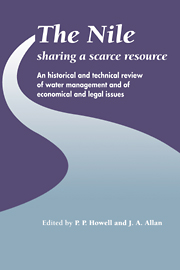 The Nile: Sharing a Scarce Resource
The Nile: Sharing a Scarce Resource Book contents
- Frontmatter
- Contents
- Preface
- List of Contributors
- Orthography
- Units and Conversion Factors
- Introduction
- I Environmental history of the Nile and its management
- II Nile management and factors affecting future management
- 6 Global climate change and the Nile Basin
- 7 Hydrological data requirements for planning Nile Management
- III Future utilisation of Nile waters
- IV Economic, international and legal issues
- Index
7 - Hydrological data requirements for planning Nile Management
Published online by Cambridge University Press: 05 February 2012
- Frontmatter
- Contents
- Preface
- List of Contributors
- Orthography
- Units and Conversion Factors
- Introduction
- I Environmental history of the Nile and its management
- II Nile management and factors affecting future management
- 6 Global climate change and the Nile Basin
- 7 Hydrological data requirements for planning Nile Management
- III Future utilisation of Nile waters
- IV Economic, international and legal issues
- Index
Summary
Introduction
The main requirement for hydrological records in the Nile Basin relates to river flow volumes for irrigation and hydro-electric power production. Longterm flow records exist at many sites throughout the basin, and continuity of these records is essential for future management, particularly in the light of long-term changes in relations between the main tributaries. Long records are required to extend short-term records by correlation, which includes crossborder correlation. Consistent quality is important and is best assessed by analysis of rating curves as water balance comparisons are difficult. The planning of water conservation measures to reduce evaporation losses requires monitoring of wetlands by long-term measurements supplemented by satellite imagery. The need for flood forecasting may also require satellite monitoring.
The aim of this chapter is to outline the hydrological data required for the planning of Nile waters development, and then to review present information to determine how far these requirements are met by records currently being collected. The chapter deals with surface water as opposed to groundwater resources. It treats the whole basin as a unit in terms of scientific knowledge, though the responsibility for data collection is divided between a number of different national authorities, who may have different priorities in terms of water resources management.
The Nile Basin, because of its size and the variety of climate and topography, constitutes one of the most complex of major river basins.
- Type
- Chapter
- Information
- The Nile: Sharing a Scarce ResourceA Historical and Technical Review of Water Management and of Economical and Legal Issues, pp. 163 - 192Publisher: Cambridge University PressPrint publication year: 1994
- 2
- Cited by


